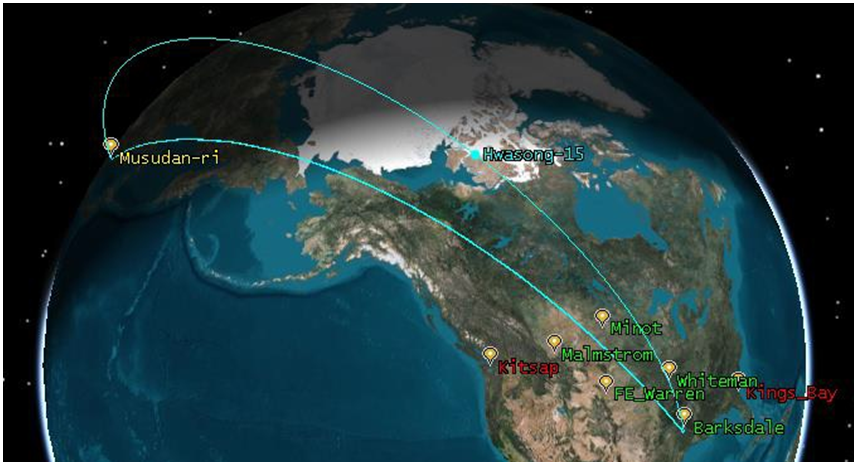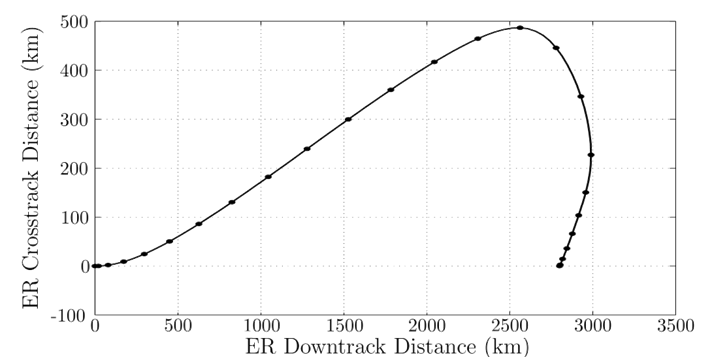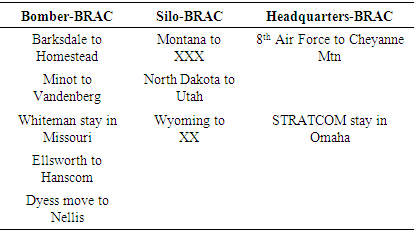-
Paper Information
- Paper Submission
-
Journal Information
- About This Journal
- Editorial Board
- Current Issue
- Archive
- Author Guidelines
- Contact Us
Science and Technology
p-ISSN: 2163-2669 e-ISSN: 2163-2677
2018; 8(1): 11-16
doi:10.5923/j.scit.20180801.02

Eliminating the Existential Threat from North Korea
Scott Nakatani1, Timothy Sands2
1Space Systems Academic Group, Naval Postgraduate School, USA
2Department of Mechanical Engineering, Stanford University, USA
Correspondence to: Timothy Sands, Department of Mechanical Engineering, Stanford University, USA.
| Email: |  |
Copyright © 2018 The Author(s). Published by Scientific & Academic Publishing.
This work is licensed under the Creative Commons Attribution International License (CC BY).
http://creativecommons.org/licenses/by/4.0/

The immergence of a belligerent North Korea threatening the United States with nuclear weapons is a new, shocking development that takes place in a paradigm that finds the U.S. in an outdated posture that stems largely from the laydown of its land-based nuclear forces. This research illustrates the vulnerability of the entire land-based nuclear force to a single North Korean nuclear ballistic missile launch via orbital dynamics and also rotational mechanics for attitude control to illustrate cross-track maneuverability producing a theorem that hypothesizes the new threat. This theorem is postulated, and then scientific analysis is provided as proof. With acceptance of this validated vulnerability, suggestions are offered to negate the vulnerability via the Base Realignment and Closure (BRAC) process. This process is required for any major realignment of U.S. force posture, so any defensive dispersal of land-based nuclear forces must rely upon the BRAC process to negate the new threat.
Keywords: Astrodynamics, Orbital analysis, Ballistic missile, Warhead maneuvering, Control moment gyroscope, Base Realignment and Closure, Nuclear deterrence, North Korea
Cite this paper: Scott Nakatani, Timothy Sands, Eliminating the Existential Threat from North Korea, Science and Technology, Vol. 8 No. 1, 2018, pp. 11-16. doi: 10.5923/j.scit.20180801.02.
Article Outline
1. Introduction
- International relations as it pertains to conflict has evolved in recent years from the cold war nuclear standoff to a fluid period of periodic conflict referred to as “low-end” warfare, amidst a global context of nuclear proliferation and failure of old international nuclear agreements. In this broadest context we see North Korea as the most recent nuclear power overtly threatening the United States with nuclear war. Upon examination, this research reveals considerable vulnerabilities that result from the current American force posture and laydown. The main aim of this manuscript is to highlight the vulnerabilities to the new threat and recommend some corrective actions by providing key background studies to aid decision analysis. The importance of the research cannot be understated, since national survival is at stake, and yet diverging hypotheses are not yet present in the literature, therefore this research serves the purpose of initiating the discussion of how to respond to the latest developments in international relations. A unique contribution of this manuscript is reinforcement of the assertions with scientific analysis to demonstrate the theorems proposed. The principle conclusion is that a mandatory dispersal of American land-based nuclear forces is paramount to address the new threats of the modern world, and specific recommendations for dispersal are offered, albeit merely to commence the discussion and debate. The analysis is presented sequentially with relevant citations provided enroute, beginning with a discussion of the laydown of American land-based nuclear forces, continuing next with the assertion that this laydown is inappropriate to modern conflict due to the immergence of North Korea as a nuclear power, and then lastly analysis is given to prove the theorems and propositions offered. Finally, some potential immediate actions are suggested to alleviate the new vulnerability.
2. Decision Analysis for Base Locations in the Context of Modern Conflict
- This section establishes the current laydown of American, land-based nuclear forces, and this laydown establishes the current nuclear posture which was based on the cold war’s aftermath; but is seen to be highly inappropriate for modern threats. A very brief divergence is taken to provide the reader with one of the rationales for the current positioning of forces. With this backdrop, space is identified as a key domain of modern warfare, and then analytical methods are taken from the academic discipline of astronautics and applied to the problem of North Korea’s modern threats. Two themes of astronautics are particularly useful: astrodynamics/orbital mechanics, and rotational mechanics as it applies to attitude control of ballistic missiles and warheads. Scientific analysis and numerical simulations clearly articulate the new threat and the nature of the analysis hint at one potential solution: defensive dispersal.
2.1. Location of American Land-based Strategic Forces
- The current locations of American, land-based nuclear forces have been concentrated in Wyoming, North and South Dakota, Montana, Louisiana, Missouri, and Texas. An oft spoke mantra is that these locations are very safe, since an adversary must “attack the nation’s heartland” to destroy these bases, thus guaranteeing an assured nuclear response from the U.S., and thereby providing nuclear deterrence through nuclear assurance. This research will postulate that these locations are on a single sub-orbital trajectory from North Korean nuclear missile launch sites, and represent an existential threat to the U.S.
2.1.1. Culture Change in the Air Force and Accompanying Base Realignments
- Consider the question of “why” the strategic forces are placed on the bases listed above. What are some of the rationales for the current laydown of forces? One justification frequently espoused is the protected nature of these positions in “the nation’s heartland”. This is particularly relevant to strategic deterrence arguments that highlight the necessity of striking the American heartland en masse in order to negate the nuclear missile launch sites. Such a requirement provides a kind of strategic deterrence. Adversaries are deterred from seeking a decapitating nuclear strike, since they must be fully committed to the destruction of America or else they face assured destruction in an American response. Another justification for the location of the nuclear forces is possibly reduction of stature of the nuclear mission amidst the rise of a fighter-pilot driven culture in the American Air Force. Leadership positions (especially General Officers) are dominated by fighter pilots and even displays of Air Force heritage hail the actions of historic fighter pilots. Perhaps-coincidentally, numerous nuclear missile and bomber bases that were located all across the nation have been concentrated from other desirable coastal locations to the bayou of Louisiana, the Texas desert, and the upper tundra of North and South Dakota, Wyoming, and Montana, while bases formerly home to nuclear forces in California, Maine, and Florida (amongst many others) now are home to fighter aircraft. The list of former nuclear bomber bases that are now closed is long, and some of them are listed here: • Castle Air Force Base (AFB) was formerly a nuclear bomber base in Merced California; • Fairchild AFB in Washington State was a nuclear bomber base since 1947 but now only has tanker aircraft. • Mather AFB near Sacramento California maintained nuclear bombers for 30 years before closing. The last B-52 flight leaving Mather AFB is celebrated on YouTube (YouTube, 2010). • Homestead AFB in Florida was a nuclear bomber base since 1955, but now has light fighters. • Loring AFB in Maine was built in 1953 as the biggest Strategic Air Command base in the country, but has since closed. In total, the Strategic Air Command formerly maintained 109 bases in the states, 3 bases on U.S. territories overseas (including Hawaii and Guam), 2 bases in Canada, and 17 bases in Britain, amongst many others. (Wiki, 2018)
2.2. Era of Modern Conflict
- In recent years, military conflict has been dominated by so-called “low end” conflicts with non-state actors, terrorists, and criminal networks (Sands, 2016). Amidst this pre-occupation with such conflicts, global strategic nuclear relationships have deteriorated (Mihalik, 2016) resulting in a reassessment by the United States of its nuclear posture (Mihalik, 2018), (Camacho, 2018), while the air force, who owns the land-based nuclear forces has initiated a recapitalization of its nuclear enterprise, including increasing the critical thinking skills of its members. (Sands, 2017) Despite the insinuations that rise from calling a conflict “low end”, the conflicts over the past few two decades have brought a reality that technological advancement provides significant inexpensive, unconventional advantages to adversaries. Ubiquitous use of services from space are no longer reserved for large-scale military forces, although military forces still use space in unique ways (Sands, 2009), (Nakatani, 2018), (Sands, 2018).
2.2.1. Dependence upon Space
- Global time-of-day is provided by navigation systems in orbit (e.g. the global positioning system GPS, GLONASS, Beidu). These capabilities alone allow adversaries to synchronize attacks to maximize success by leveraging principles of surprise, and massing of effects. Sub-orbital ballistic missiles have gradually become more accurate in part due to precision timing and navigation capabilities from space. Unfortunately, nations’ citizens are unaccustomed to thinking about navigation in terms orbital terms, and accordingly it would not be intuitive to learn that most of the locations of the nation’s strategic forces (the land-based bombers and ballistic missiles) are nearly upon a single line of sub-orbital navigation. Theorem 1. Locations of strategic systems have been placed in manner that makes the nation’s missile and bomber forces vulnerable to a decapitating first-strike.
 | Figure 1. Satellite Toolkit (STK) simulation revealing Musudan-ri launch trajectory |
 | Figure 2. Satellite Toolkit (STK) simulation revealing Musudan-ri launch trajectory |
 | Figure 3. Maneuvering re-entry vehicle optimal cross-track capabilities (Rao, 2002) |
|
3. Discussion
- The analysis of section 2 illustrates the imperative. Table 1 lists merely contains a list of some recommendations with the motivation of highlighting rationales for placement of particular capabilities: 1) spread bases east-to-west to complicate adversary targeting, 2) place bombers near coast to enhance conventional deployment and provide routine access to overseas training areas, 3) place silos slightly away from the coast to lengthen decision timelines in response to submarine launched ballistic missile attacks, and 4) place the nuclear headquarters in safe places that are also dispersed east-to-west. In general, spread bases north-to-south as well to enhance survivability.
4. Materials and Methods
- Orbital analysis begins with first-principle understandings of universal gravitation and ends with utilization of Satellite Toolkit (STK) software, where educated inputs may be quickly iterated to reveal realistic missile trajectories from specific initial and final points on the earth’s surface. Figures 1 and 2 are graphical STK output for the scenario requested as educated inputs. Cross-track analysis is slightly more complex. Control moment gyroscopes are assumed to provide momentum exchange for attitude reorientation (Zhong, 2010), (Lu, 2018), while attitude coupling to aerodynamic forces results in missile and warhead maneuvers. Geometric installation of the control moment gyroscopes are taken from (Sands, 2006) resulting in robust singularity reduction per (Kim, 2009) and (Kim, 2012), which were experimentally validated in (Kim, 2016) and patented in (Agrawal, 2017) as articulated in (Kim, 2018). Singularity penetration (Kim, 2018) was not assumed in the simulations in this research. Singularity penetration provides enhanced maneuverability, and neglecting this capability makes the assertions made in this manuscript conservative. Furthermore, two distinct lines of recent developments in system identification (Sands, 2017), (Kenny, 2017), (Armani, 2018), (Sands, 2017-1), (Kenny, 2017-1) augmenting nonlinear control methods (Sands, 2012), (Cooper, 2017), providing battle damage tolerance space systems (Nakatani, 2014), (Nakatani, 2016), (Nakatani, 2018) are similarly assumed not to be available to the North Korean ballistic missiles, making the assertions here even more conservative. The mathematical problem was exactly solved using optimization methods (Rao, 2002), and such analysis provides high-confidence in the validity of the notions asserted here. Particularly following the failed 2010 and 2015 nuclear non-proliferation treaty review conferences (Mihalik, 2016), these latest develops herald a renewed emphasis on nuclear deterrence in the United States including a rigorous education component (Camacho, 2017), (Mihalik, 2017) to increase the critical thinking abilities of nuclear forces, and have natural spinoff applications to military missions in general, e.g. electronic warfare (Sands, 2009) and space systems (Sands, 2018), in particular. This renewed emphasis is the result of an admission that the U.S. has been pre-occupied with insurgency-types of warfare (Sands, 2016), and this preoccupation must be corrected, especially in light of such existential threats as the one discussed in this manuscript. The re-invigoration of the nuclear enterprise articulated above has been very recently been strongly reinforced with the release of the American nuclear posture review (Camacho, 2018), (Mihalik, 2018). In this context, now is clearly the right time to propose drastic actions, such as realigning nuclear forces. Author Contributions: Timothy Sands conceived and designed the analysis; Scott Nakatani performed the simulation experiments; Scott Nakatani and Timothy Sands analyzed the data; Timothy Sands wrote the paper. Authorship has been limited to those who have contributed substantially to the work reported.
 Abstract
Abstract Reference
Reference Full-Text PDF
Full-Text PDF Full-text HTML
Full-text HTML